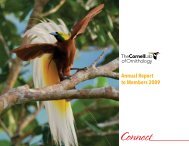National Survey of Fishing, Hunting, and Wildlife ... - All About Birds
National Survey of Fishing, Hunting, and Wildlife ... - All About Birds
National Survey of Fishing, Hunting, and Wildlife ... - All About Birds
You also want an ePaper? Increase the reach of your titles
YUMPU automatically turns print PDFs into web optimized ePapers that Google loves.
<strong>Wildlife</strong> Fed, Observed, orPhotographed by Around-The-HomeParticipantsOf the 52.8 million people feedingwildlife around their homes in 2011,95 percent (50.2 million) fed wildbirds, while 28 percent (14.8 million)fed other wildlife.Approximately 45.0 million participantsclosely observed wildlife aroundtheir homes, <strong>of</strong> which 41.3 millionobserved birds. Observing mammalswas undertaken by 35.9 million participants.Insects <strong>and</strong> spiders attractedthe attention <strong>of</strong> 16.6 million people;14.1 million observed amphibiansor reptiles; <strong>and</strong> 8.4 million peopleobserved fish <strong>and</strong> other wildlife. Themedian number <strong>of</strong> days for around-thehomeobservations for all animals wasa little over 87 days in 2011.<strong>About</strong> 25.4 million people photographedwildlife around their homes.The median number <strong>of</strong> days peopletook pictures <strong>of</strong> wildlife around theirhomes in 2011 was 4 days, although 3.7million people (15 percent) photographedwildlife 21 days or more.Around-The-Home <strong>Wildlife</strong>Watchers by Geographic RegionIn 2011, over 239 million people 16years old or older lived in the UnitedStates. Of those, 29 percent wildlifewatched around their homes. Theparticipation rates <strong>of</strong> these around-thehomeparticipants varied by region.The percentages <strong>of</strong> regional populationsthat wildlife watched aroundtheir homes ranged from 24 percent inthe Pacific Region to 35 percent in theEast North Central Region. The NewEngl<strong>and</strong>, East North Central, WestNorth Central, <strong>and</strong> East South Centralhad participation rates above thenational average <strong>of</strong> 29 percent.The regions making up the largestnumber <strong>of</strong> around-the-home wildlifewatchers in the United Stateswere the South Atlantic (12.8 millionparticipants) <strong>and</strong> the East North CentralRegion (12.5 million participants).Pacific24%Insects orspidersAmphibiansor reptilesFish orother wildlifeHIMammalsCAPercent <strong>of</strong> Around-The-Home Observersby Type <strong>of</strong> <strong>Wildlife</strong> Observed(Total wildlife observers: 45.0 million)<strong>Birds</strong> 92%AKORWA19%31%37%Percent <strong>of</strong> Around-The-Home Photographersby Days Spent Photographing <strong>Wildlife</strong>(Total wildlife photographers: 25.4 million)1 day17%2 to 3 days23%NVIDAZUTMTWYNMCONDSDNETXKSOKMNIAMOARLAWIILMSINTNMIAL21 days or more15%11 to 20 days12%6 to 10 days17%4 to 5 days15%Around-The-Home <strong>Wildlife</strong>-Watching Participation(<strong>National</strong> participation rate: 29 percent)Mountain28%West NorthCentral33%West SouthCentral26%EastNorthCentral35%KYOHEast SouthCentral31%GAWVSCFLPAVANC80%NHVTNew Engl<strong>and</strong>33%MEMANYRICTNJDEMDDCSouth Atlantic28%MiddleAtlantic27%U.S. Fish <strong>and</strong> <strong>Wildlife</strong> Service <strong>and</strong> U.S. Census Bureau 2011 <strong>National</strong> <strong>Survey</strong> <strong>of</strong> <strong>Fishing</strong>, <strong>Hunting</strong>, <strong>and</strong> <strong>Wildlife</strong>-Associated Recreation 39






